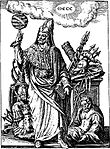Ahmad al-Buni

| Part of a series on |
| Hermeticism |
|---|
 |
Sharaf al-Din, Shihab al-Din, or Muḥyi al-Din Abu al-Abbas Aḥmad ibn Ali ibn Yusuf al-Qurashi al-Sufi, better known as Aḥmad al-Būnī Almalki (Arabic: أحمد البوني المالكي, d. 1225), was a medieval mathematician and Islamic philosopher and a well-known Sufi. Very little is known about him. His writings deal with 'Ilm al-huruf (Arabic: علم الحروف, the esoteric value of letters) and topics relating to mathematics, siḥr (sorcery) and spirituality.[1][2] Born in Buna in the Almohad Caliphate (now Annaba, Algeria), al-Buni lived in Ayyubid Egypt and learned from many eminent Sufi masters of his time.[3]
A contemporary of ibn Arabi,[4] he is best known for writing one of the most important books of his era; the Shams al-Ma'arif, a book that is still regarded as the foremost occult text on talismans and divination.
Contributions[edit]

Theurgy[edit]
Instead of sihr (Sorcery), this kind of magic was called Ilm al-Hikmah (Knowledge of the Wisdom), Ilm al-simiyah (Study of the Divine Names) and Ruhaniyat (Spirituality). Most of the so-called mujarrabât ("time-tested methods") books on sorcery in the Muslim world are simplified excerpts from the Shams al-ma`ârif.[5] The book remains the seminal work on Theurgy and esoteric arts to this day.
Mathematics and science[edit]
In c. 1200, Ahmad al-Buni showed how to construct magic squares using a simple bordering technique, but he may not have discovered the method himself. Al-Buni wrote about Latin squares and constructed, for example, 4 x 4 Latin squares using letters from one of the 99 names of God. His works on traditional healing remain a point of reference among Yoruba Muslim healers in Nigeria and other areas of the Muslim world.[6]
Influence[edit]
His work is said to have influenced the Hurufis and the New Lettrist International.[citation needed]
Denis MacEoin, in a 1985 article in Studia Iranica, said that al-Buni may also have indirectly influenced the Twelver Shi'i radical movement known as Bábism. MacEoin said that Bābis made widespread use of talismans and magical letters.[7]
Writings[edit]

- Shams al-Maʿārif al-Kubrā[8] (The Great Sun of Gnosis), Cairo, 1928.
- Sharḥ Ism Allāh al-aʿẓam fī al-rūḥānī, printed in 1357 AH or in Egypt al-Maṭbaʿa al-Maḥmudiyya al-Tujjariyya bi'l-Azhar.
- Kabs al-iktidā, Oriental Manuscripts in Durham University Library.
- Berhatiah, Ancient Magick Conjuration Of Power.
- Treatise on the Magical Uses of the Ninety-nine Names of God in the Khalili Collection of Islamic Art[9]
References[edit]
- ^ B. G. Martin, Muslim Brotherhoods in Nineteenth-Century Africa, Cambridge University Press, 2003, p.149
- ^ Dietrich, A., “al-Būnī”, in: Encyclopaedia of Islam, Second Edition, Edited by: P. Bearman, Th. Bianquis, C.E. Bosworth, E. van Donzel, W.P. Heinrichs, p. 149
- ^ By C. J. Bleeker, G. Widengren, Historia Religionum, Volume 2 Religions of the Present, p.156,
- ^ Vincent J. Cornell, Realm of the Saint: Power and Authority in Moroccan Sufism, University of Texas Press, 1998, p. 221
- ^ Martin van Bruinessen, "Global and local in Indonesian Islam", Southeast Asian Studies (Kyoto) vol. 37, no.2 (1999), 46-63
- ^ Sanni, Amidu (2002). "Diagnosis through rosary and sand: Islamic elements in the healing custom of the Yoruba (Nigeria)". Medicine and Law. pp. 295–306.
- ^ Mac Eoin, D.M. (1985). "Nineteenth-century Babi Talismans". Studia Iranica. 14 (1): 77–98. doi:10.2143/SI.14.1.2014664.
- ^ "Shams ul Maarif ul Kubra Urdu, شمس المعارف الکبریٰ, اردو, لطائف العوارف".
- ^ Rogers, J. M. (2008). The arts of Islam : treasures from the Nasser D. Khalili collection (Revised and expanded ed.). Abu Dhabi: Tourism Development & Investment Company (TDIC). p. 170. OCLC 455121277.
Notes[edit]
- Edgar W. Francis, Mapping the Boundaries between Magic. The Names of God in the Writings of Ahmad ibn Ali al-Buni
